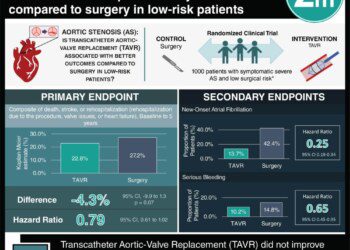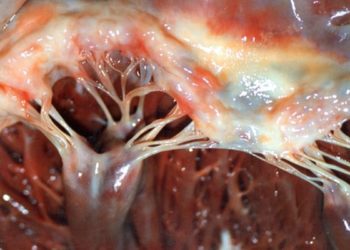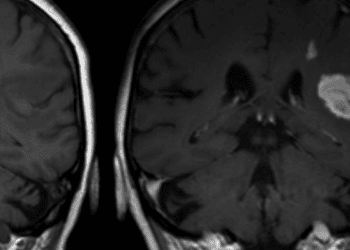Association between transcatheter aortic valve replacement and subsequent infective endocarditis and death
1. Among all patients undergoing transcatheter aortic valve replacement, an increased risk of infective endocarditis was found in males, younger age groups, those with a history of diabetes mellitus, and those with aortic regurgitation.
2. Those patients who developed infective endocarditis had a significantly elevated rate of in-hospital mortality and 2-year mortality.
Evidence Rating Level: 2 (Good)
Study Rundown: Transcatheter aortic valve replacement (TAVR) has emerged as a beneficial therapeutic option in patients with aortic stenosis for whom surgery poses undue risk. While open surgical procedures may lead to subsequent infective endocarditis (IE)—and associated morbidity and mortality—data on IE after TAVR remains limited. This retrospective cohort study from 31 centers in North America, South America, and Europe, evaluated the outcomes and clinical characteristics of patients who developed infective endocarditis after TAVR. Patients with younger age, male sex, a history of diabetes mellitus, and moderate-to-severe aortic regurgitation were more likely to develop IE. Patients who developed endocarditis experienced greater morbidity and mortality, both in-hospital and 2-years following the procedure.
This study provides insight into the risks of IE after TAVR, however it limited in a few important ways. First, given its retrospective design, caution should be exercised in interpreting the association between IE and TAVR, as the results may be due in part to bias and other unmeasured confounders. Additionally, no external monitoring body verified the accuracy of data across the many centers involved in this study. Further, prospective studies should be undertaken to better understand the risks associated with TAVR.
Click to read the study, published today in JAMA
Relevant Reading: Infective Endocarditis Following Transcatheter Aortic Valve Implantation: Results from a Large Multicenter Registry
In-Depth [retrospective cohort trial]: This study evaluated patients who developed infective endocarditis after receiving transcatheter aortic valve replacement (TAVR). It was a multicenter, multi-continent study, encompassing 31 centers across North America, South America, and Europe. Patients included within the registry underwent TAVR, and all centers included patients who either had a definitive diagnosis of infective endocarditis, or patients who did not develop endocarditis and had at least 1 year of follow-up. The primary outcome measure was the development of infective endocarditis post-TAVR, and secondary measures looked at demographics and clinical characteristics to assess the relative incidence between the endocarditis cohort and the control cohort (no endocarditis).
250 patients out of a total of 20,006 developed infective endocarditis. Patients with infective endocarditis had a younger mean age of 78.9 years (95%CI 77.6 to 80.2) vs 81.8 years (95%CI 81.6 to 82.0; difference -2.8 years; 95%CI -4.2 to -1.4 years; p < 0.001). About 62% of patients with endocarditis were men, vs. 49.7% (difference 12.3%; 95%CI 2.8% to 21.0%; p = 0.01). Those with IE were also more likely to have diabetes mellitus (difference 11.6%; 95%CI 2.7% to 21.1%; p < 0.009). In-hospital death occurred in 90 cases (36%; 95%CI 30.0% to 41.9%). The most common symptoms at presentation were fever (80.4%; 95%CI 75.5% to 85.3%) and acute heart failure (40.0%; 95%CI 39.3% to 51.7%). Patients who died in the hospital were more likely to have a higher logistic EuroSCORE (OR 1.03 per 1% increase; 95%CI 1.00 to 1.05; p = 0.02), heart failure at admission (OR 3.36; 95%CI 1.74 to 6.45; p < 0.001), and acute kidney injury (OR 2.70; 95%CI 1.42 to 5.11; p = 0.002).
Image: CC/Wiki
©2016 2 Minute Medicine, Inc. All rights reserved. No works may be reproduced without expressed written consent from 2 Minute Medicine, Inc. Inquire about licensing here. No article should be construed as medical advice and is not intended as such by the authors or by 2 Minute Medicine, Inc.







